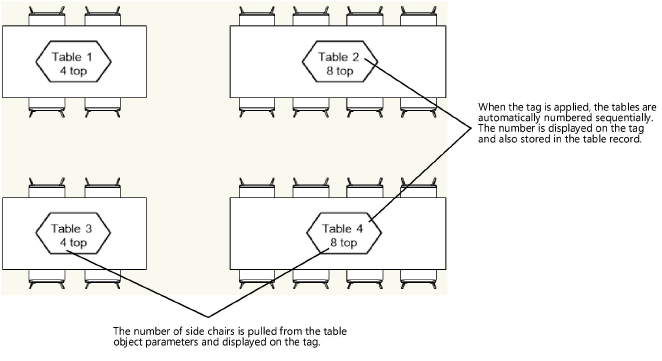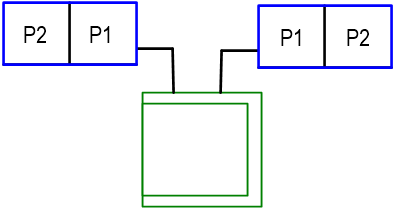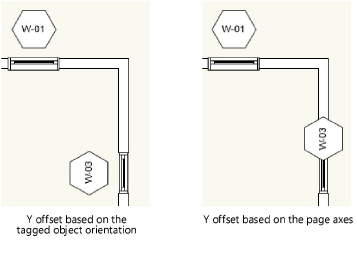 Creating data tag styles
Creating data tag styles
The Vectorworks resource libraries provide many commonly used tags, such as window and door type IDs and date stamps. If you need a tag for a different type of object (such as columns), or to show different data (such as window dimensions), create a custom data tag style. Once a tag style is created, you can select it from the Resource Selector on the Tool bar or on the Data Tag Settings dialog box.
 Creating a basic data tag style
Creating a basic data tag style
|
Command |
Path |
|
Create Data Tag Style |
Tools |
Quickly create a basic data tag style from an existing object in the drawing. The object must have data attached, such as a plug-in object with parameters, a symbol with a record attached, or an object with IFC data attached.
To create a data tag style:
Select an object in the drawing that needs a tag.
Select the command. The Create Data Tag Style dialog box opens.
All available properties that can be used on the tag are listed. Enter a Style Name.
Click the Use column for each item to display on the tag. If desired, also click Use Label to include the Label shown; you can click the Label field and edit it, if needed. Select a Tag Shape to be drawn around the label and/or object property, if desired. When you've finished selecting properties for the tag, click OK.
If the Style Name is already in use, an alert displays.
From the Select Folder dialog box, select the destination folder for the data tag style.
The tag is attached to the object. The new style is added to the Resource Manager for the current file and is now available for use with the Data Tag tool.
 Editing a data tag style
Editing a data tag style
To adjust the tag settings or fine-tune the layout, edit the tag style. Styles allow you to set fixed values for some of the parameters for all instances that use the style, while maintaining the ability to edit other parameters for each instance of the tag. See Concept: Plug-in object styles.

To edit a data tag style:
Do one of the following:
From the Resource Manager, select the existing resource in the active file. Right-click on the resource and select Edit from the context menu.
Select an existing data tag in the drawing. From the Object Info palette's Style list, select Edit Style.
Alternatively, right-click on the data tag and select Edit Plug-in Style from the context menu.
The Data Tag Style dialog box opens.
Edit the Style Name if desired.
Click the Leader tab to specify options for a tag leader.
Click to show/hide the parameters.Click to show/hide the parameters.
|
Parameter |
Description |
|
Use Leader |
Draws a leader line with the tag; specify the leader parameters |
|
Leader Type |
Select line, arc, or Bézier as the line type |
|
Default Shoulder Length |
Enter a default length for the leader shoulder in page units, or enter 0 (zero) for no shoulder; after placement, you can move the shoulder control point to adjust the length |
|
Leader Radius |
If the Leader Type is arc, enter the arc radius in page units |
|
Marker |
Includes a marker at the end of the leader; select the marker style; for details, see Marker attributes |
|
Leader/Shoulder Class |
Select an existing class, or create a new class. Select <Data Tag Class> to place the leader in the same class as the data tag object. |
|
Horizontal Position |
Specify whether to extend the shoulder left or right from the leader line; select Auto to vary the shoulder position automatically according to the tag position |
|
Move _ with Object |
Specify whether to move the entire tag or only the end of the leader line when the associated object is moved |
|
Allow Multiple Attachment Points |
Enables the leader to attach to the tag at the nearest attachment point, defined by loci in the tag layout |
Click the Display tab to specify the tag display options.
Click to show/hide the parameters.Click to show/hide the parameters.
|
Parameter |
Description |
|
Align to Walls/Objects |
Rotates the tag to the angle of the associated object; for walls, data tags will be rotated as if they are inserted in the wall |
|
Wall Alignment |
Specify the part of a wall for aligning the tag: centerline, left or right edge, or unconstrained |
|
Always Display Edit Tag Data Dialog |
Displays a data entry dialog box each time the tag is placed in a drawing |
|
Mirror Elements |
If Use Leader is selected and the Horizontal Position is set to Left or Auto on the Leader tab, select this option to mirror the positions of the defined tag elements when the tag is on the left side of the leader line. When deselected, the tag elements are always in the defined positions.
Mirrored tag on left, defined tag on right |
|
Scaling |
Adjusts the scale of the label: Symmetric changes the width and height equally by the Factor specified Asymmetric changes the width by the X Factor and the height by the Y Factor |
|
Scale Text |
Adjusts the scale of the label text using the scaling factors; for asymmetric scaling, the text size is controlled by the X Factor, and the text position is controlled by both factors |
|
X/Y Factor |
Enter a factor for scaling the label (for example, enter 2 to double the label size, or enter 0.5 to reduce the label to half the original size) |
|
Edit Tag Layout |
Opens a tag editing window, to define the geometry of the tag and the data fields shown on it (see steps 7 through 9) |
Click the Auto-placement tab to specify the options for positioning data tags by default, when they are placed with All Eligible Objects or Selected Eligible Objects mode.
Click to show/hide the parameters.Click to show/hide the parameters.
|
Parameter |
Description |
|
Base Offset on |
Specify whether to offset the tag relative to the tagged object’s coordinate system or relative to the page axes. The Tagged Object Orientation option requires Top/Plan view.
|
|
X/Y Offset |
Enter the X and Y offsets from the center of the bounding box of the associated object, as projected onto the notation plane. Measurements are in page units. |
|
Leader Length |
If Use Leader is selected on the Leader tab, enter the length of the default leader line |
|
Leader Angle |
If Use Leader is selected on the Leader tab, enter the angle of the default leader line |
Click the Defaults tab, and for each dynamic text object on the tag, specify its next value (for an incrementing field) or the default value (if applicable).
From the Display tab, click Edit Tag Layout.
In the tag editing window, draw the geometry of the tag in page units using any planar graphic tools. The origin (0,0) point is always the primary attachment point for a leader line, if used. To define an alternate attachment point, add a 2D locus to the geometry, and enable Allow Multiple Attachment Points in the Data Tag Style dialog box.
Use the Text tool to add static and/or dynamic text objects to the tag. From the Object Info palette, specify the appearance of the text; see Formatting text for more information about the options available.
Static text simply shows the text object on each tag.
Dynamic text shows data from the tagged object (for example, the width of the window) on each tag, in place of the text object. To create dynamic text, select the text object and click Use Dynamic Text from the Object Info palette. Then click Define Tag Field to open the Define Tag Field dialog box.
Click to show/hide the parameters.Click to show/hide the parameters.
|
Parameter |
Description |
|
Field Label |
Enter the text to display for this field in the tag layout and Edit Tag Data dialog box |
|
Calculated Field |
Select this option to use data pulled from the drawing in the field, or to use automatically incrementing numbers or letters. You can include multiple data sources in the same field. |
|
Current Tag Field Definition |
Variables are placed in this field automatically by your Data Source and Data Destination selections. The definition can include multiple data sources, such as the floor the object is on, followed by an incrementing value for each object. You can manually add static text or punctuation, as well as simple arithmetic operators (which operate on numerical fields only). For example, to display the price of an appliance with a 10 percent markup from the actual price in the appliance record, you might enter something like this: #Appliance Record#.#Price# + #Appliance Record#.#Price# * 0.1 You can also use a logical IF function in the definition, where the first result is if your comparison is true, the second if your comparison is false. For example, the statements below are both valid syntax, and they both translate as follows: if the area of a space is greater than 12, return “Yes”; otherwise, return “No.” Yes@#Space#.#Area#>12:No #WS_IF(('Space'.'Area'>'12'), 'Yes', 'No')# When you include a worksheet function as in the second example, the formula syntax is the same as it would be in a worksheet, except that the formula is preceded by the characters #WS_ and followed by another # character. |
|
Data Source |
Specify the source of the data to display on the tag. Different options are available for each source. Object Parameters: Select the Object Name and which Parameter Name to use (for example, window and window width). Record Format: Select the Format Name and which Field Name from the record format to use (for example, plant record and light range). IFC Entity: To display pSet values (such as Classification) regardless of the object’s IfcEntity, select AnyIfcEntity, and then select the pSet Name and Property Name to use. To display data for a specific IFC entity, select Choose new IFC Entity, and then from the Select IFC Object dialog box, select an object; the object is displayed in the IfcEntity field. Then select the pSet Name and Property Name to use. To use one of the IFC entity’s “base” values (such as “name”), select the IFC entity name from the pSetName list. Object Function: Select an object-specific Function (for example, area). General Function: Select a general Function (for example, sheet number). Incrementing Value: Select a format for the value (integer, lower-case character, upper-case character). Then click Sequence Settings to enter the Start Value, Increment, and Next Value to use. Worksheet Function: Select an object-specific Function (for example, volume). If the function you want isn't on the list, enter it in the tag field definition manually, using the format #WS_[function]# (for example, #WS_VOLUME#). If you select a data source that has a unit type of dimension, area, volume, or angle, additional fields display for setting the Units and Precision. Select Show unit/mark to show a unit mark along with the unit value. If the units and precision settings are different from those set for the document, the settings are added to the field definition. For example, #m_2_1# indicates the tag will use meters with precision .01. |
|
Link field |
Links the selected Data Source field to the selected Data Destination field of the object. For example, you might have a door tag with a field that extracts the Configuration setting from the door’s object parameters. You can link the field to the Operation Type field in the door’s IFC record, to automatically update the IFC record when a door is tagged. |
|
Data Destination |
Specify the destination for the extracted data. Different options are available for each destination. Object Parameters: Select the Object Name and which Parameter Name to use (for example, window and window width). Record Format: Select the Format Name and which Field Name from the record format to use (for example, plant record and light range). IFC Entity: From the Select IFC Object dialog box, select an object; the object is displayed in the IfcEntity field. Select the pSet Name and Property Name to use. |
|
Add to Definition / |
After you select the details for a data source (and an additional destination for the data, if applicable), these buttons add to or replace the variables in the Current Tag Field Definition window |
|
User-entered Field |
Select this option to allow the user to enter data for the field when the tag is placed |
|
Field Type |
Select the type of data to enter in the field: Text: Field for entry of a string of characters, such as a word or sentence Integer: Field for entry of whole numbers (uses less memory than a Real Number field) Boolean: A check box Real Number: Field for entry of general numbers, or numbers of a specific format, such as fractions, dimensions, or dates; click Define to specify a format Pop-up: List of options to select from; click Define to enter the options |
|
Define |
If the Field Type is Pop-up, opens the Edit Choices dialog box. Enter the options to display, pressing Enter (Windows) or Return (Mac) to separate each item. If the Field Type is Real Number, opens the Number Format dialog box; select a format. General: The default general number format Decimal: Enter a value for the number of decimal places, and specify whether to use commas as separators Scientific: Enter a value for the number of decimal places Fractional: Enter the rounding value for fractions Percentage: Enter a value for the number of decimal places. Entries are multiplied by 100 and are displayed with a percent symbol. Dimension: Displays the current unit mark after the number (as in " for inches) Dimension Area: Displays the current area units after the number (as in “sq ft” for square feet) Dimension Volume: Displays the current volume units after the number (as in “cu ft” for cubic feet) Angle: Select an accuracy setting (degrees, minutes, or seconds, or decimal numbers up to eight decimal places) Date: Select a date format |
|
Default |
Specify a default value. You must enter a default value for Integer and Real Number type fields. |
|
Link text value |
Links the Current Tag Field Definition to the selected Data Destination field associated with the object. For example, you might define a space tag field that includes the building the space is in, followed by the floor the space is on, followed by an incrementing value for each space. You can link the field definition to the Space Number parameter of the space object, to be used in reports. |
|
Data Destination |
Specify the destination for the text value of the tag field. Different options are available for each destination. Object Parameters: Select the Object Name and which Parameter Name to use (for example, window and window width). Record Format: Select the Format Name and which Field Name from the record format to use (for example, plant record and light range). IFC Entity: From the Select IFC Object dialog box, select an object; the object is displayed in the IfcEntity field. Select the pSet Name and Property Name to use. |
Use the layout constraints on the Object Info palette to control the positions of the text and 2D objects when the size of the tag's bounding box is different from the defined size.
|
Constraint |
Description |
|
Constrain object distance from boundary |
Constrains the distance of the object from the left, right, top, and bottom tag boundary. Text objects that are aligned (horizontally or vertically) and closely spaced will automatically maintain their defined spacing. |
|
Fix width / Fix height |
When deselected, the object scales horizontally or vertically to fit the bounding box when necessary; not applicable to text |
When you’re done editing the geometry and text fields on the tag, click Exit Tag Layout Edit and click OK in the Data Tag Style dialog box.
If there is an error in the field definition, such as parameters from two different object types or properties from different IFC entities, an alert displays.
Custom data tag example
The following example shows a custom tag for table objects. The tag has two static text objects. The two dynamic text fields are a table ID that is automatically incremented with each tag and saved to a record attached to each table, and the number of chairs, which is extracted from the table object itself.
See Creating data tag styles for details.




